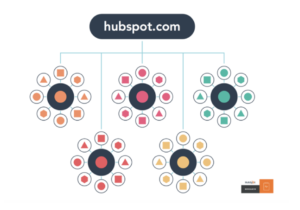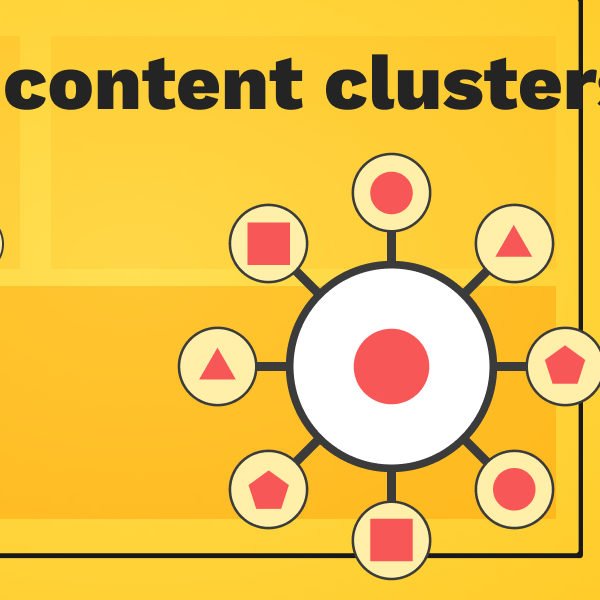Content and SEO go hand-in-hand. In 1996 Bill Gates wrote his “Content is King” essay emphasizing that, that is where the money would be made. Google, and SEO in turn, has since adopted the saying as content has always been in the forefront of the digital era. This philosophy begs the question, “How do I formulate and promote my content to be the best?”
One of the most popular methods for ranking content is the cluster formula. This cluster formula takes content topic modeling and internal linking strategy to improve the user experience of your content and boost your search performance. Below I will explore exactly why the cluster model helps SEO and how you can create your own clusters.
What Are Content Clusters?
Influential search engines like Google have changed their algorithm to favor topic-based content. As a result, SEOs are exploring a new way of linking related content under a “topic clusters” model. The basics of this format look like this:

- Pillar page — a broad, comprehensive piece of content that serves as the “center” of your cluster
- Cluster content — any piece of content internally linked to and from a cluster’s pillar page with related content that would make sense to click through to the main piece of content
- Internal links — the indicators that help navigate your readers and crawlers to your best pieces of content
The above illustration comes from one of the greatest success stories of this topic cluster model form Hubspot.com. Now that we know what a cluster is let’s look at how we can turn our content into them.
How to Create Content Clusters
The first step in creating a cluster is to take a look at your current content. What do you have that is ranking right now? Are any of those pieces worthy of being your “pillar piece”? If not, consider creating a pillar piece that is comprehensive and worthy of ranking. This typically means that it should be a long form blog piece with original data that would be of value to your readers.
If you don’t have any content on your website already then consider building a large cluster around each main product or service you offer. Or you can use a keyword tool to create ideas similarly to how you would do traditional research. The basic method you should follow is this:
- Analyze goals & conduct keyword research
- Perform a thorough content audit
- Establish pillar pages
- Implement internal linking
Remember this content is hosted on your website AND supplemented with internal linking/breadcrumbs to help guide the user and crawler in a topical way. The cluster system doesn’t work effectively if you link to non-topical pieces outside the scope of the content.
Why Do Content Clusters Work?
Search engine crawlers are always being updated to be more intelligent and actually consume content how a human would. We see this more and more with the implementation of Google’s RankBrain, Latent Semantic Indexing(LSI) and BERT into crawler algorithms.
Google RankBrain, Latent Semantic Indexing and the BERT Algorithm
The introduction of Google’s machine learning technology and natural language processing in RankBrain and BERT has completely transformed the way Google returns search results. Before, Google used to return search results based specifically on the keywords you were searching for. Now, their algorithm has a more robust understanding of the topic you are searching for and looks to return the content that it deems the most relevant. This is why creating clusters of content around topics is so effective.
Because of this advent, traditional keyword research has changed significantly over the years. We in the SEO world have gone from simply trying to rank for a term to ranking for whole topics. If a user or crawler can’t tell what the point of your content is then you can’t expect to rank.
So then how do you write for users AND search engines at the same time? Glad you asked. We’ve spoken about it in past Search Sessions here at Boostability but the idea is to write in a conversational form where you are asking and answering questions surrounding your topic throughout the content.
Why does this type of content perform well in search? Think about what a search engine does. It answers questions by pulling from their index of results to serve up the best results. If your content has the actual question and a succinct answer included right there then you have a high chance of ranking for that term.
Internal Linking Structure
Linking between articles gives Google and users indicators that your content is related and allows you to pass authority between articles. The cluster model works with this in mind pushing the authority to the pillar page. Because of this your pillar page should also have some type of re-marketing possibility. Whether that is a newsletter signup or conversion point anything would do as long as the action makes sense for the content.
Here at Boostability we are always striving to understand and implement new strategies for our clients. Content clusters are not necessarily new but it is something that everyone can implement in their own strategy. Consider giving us a call or get our free website analysis if you would like to know more about how you start ranking online like a champ!


